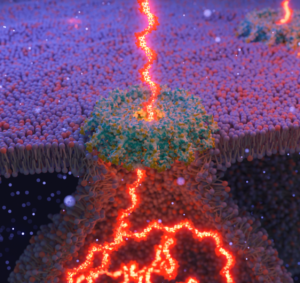Structural biology, the field that produces atomic-level structures of biomacromolecules, has undergone several revolutions in the last ten years. The latest, and possibly the most far-reaching, is the development of artificial intelligence-based prediction of atomic structures of proteins from their sequence. The program AlphaFold has thus demonstrated an amazing capability to produce atomic models of proteins whose accuracy is actually on a par with that of experimental structures derived from X-ray crystallography or high resolution cryo-electron microscopy. Previously this could be achieved only for proteins with very high sequence identity to a protein of known structure. This development is thus particularly important for RNA viruses, whose sequences diverge fast and the proteins of which consequently never have high sequence similarity to other proteins of known structures. Using AlphaFold, Dr. Thibault Tubiana, Dr. Sonia Fieulaine, and Dr. Stéphane Bressanelli modelled the hepatitis E virus (HEV) pORF1, the 1700-residue polyprotein that contains the necessary enzymatic activities to synthesise new HEV genomes in infected cells. They describe a five-domain protein, with now clear boundaries for two domains upstream and three domains donwstream the proline-rich/hypervariable region (PRR/HVR) (Figure 1).

Figure 1: New breakdown for the HEV pORF1 replication polyprotein. Residue numbers are for the genotype 1 (GT1) Sar55 strain. MetY, methyltransferase-and-Y single domain; FABD, fatty acid binding-domain; PRR (H), proline-rich/hypervariable region; X, macrodomain; HEL, helicase; RdRp, RNA-dependent RNA
The first of these, previously assigned to two distinct methyltransferase and Y domains, actually contains in a single domain both the activities necessary to cap the new viral RNAs (Met part), and interspersed membrane-interacting elements (Y part). The authors thus term this N-terminal domain MetY. The atomic structure of MetY is clearly homologous to the Chikungunya virus nsP1, despite very low sequence identity except in the methyltransferase active site. Further AlphaFold modelling allows us to propose a dodecameric assembly for MetY, as has been described experimentally for nsP1. MetY would thus form a pore allowing translocation from the membrane replication compartment to the cytosol coupled to capping of newly synthesised RNAs (Figure 2).

Figure 2: Artist’s view of a dodecameric pore of MetY and neosynthesised RNA translocation to the cytosol
Clearly missing from pORF1 is a protease domain. On the other hand, they find several stretches of mobile residues that would allow domains to relocate relative to one another even in the absence of proteolytic processing of pORF1. Apart from the above-mentioned PRR/HVR, the longest of these lies between the helicase (HEL) and polymerase (RdRp, Figure 1). Furthermore, several domains seem capable of assuming alternate conformations, including the RdRp and FABD-like domain. The team surmise therefore that structural flexibility rather than proteolytic processing could serve to regulate pORF1 functions.
The case of hepatitis C virus has shown that direct-acting antivirals could cure chronic RNA virus infection, such as occurs in most HEV infections of immunocompromised patients. This work is a step forward in defining the molecular targets for such future HEV antivirals.
Read the original article:
https://www.sciencedirect.com/science/article/pii/S0042682222002136

